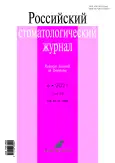Quality of life of patients with complete loss of teeth and the psychometric properties of the OHIP-20 DG questionnaire. Part 3. Investigation of latent variables
- Authors: Muslov S.A.1, Ruzuddinov N.S.2, Arutyunov S.D.1, Chizhmakov E.A.1, Moiseev S.I.3, Maslak A.A.4, Pivovarov A.A.1, Platonova M.S.1
-
Affiliations:
- A.I. Evdokimov Moscow State Medical and Dental University
- Al-Farabi Kazakh National University
- Voronezh State Technical University
- Kuban State University
- Issue: Vol 25, No 6 (2021)
- Pages: 483-493
- Section: Experimental and Theoretical Investigation
- URL: https://journals.rcsi.science/1728-2802/article/view/107464
- DOI: https://doi.org/10.17816/1728-2802-2021-25-6-483-493
- ID: 107464
Cite item
Abstract
BACKGROUND: In the rehabilitation of patients with complete loss of teeth, an important aspect is the study of their quality of life (QL) as an indicator reflecting the effectiveness of treatment.
AIM: Use latent variables and control their magnitude to control the development or suppression of symptoms in patients.
MATERIAL AND METHODS: Within the framework of the modern theory of latent variables, the study examined the QL of patients with complete loss of teeth at various stages of dental orthopedic treatment.
RESULTS: The average relative error of the forward and reverse conversion of the “polytomic score indicators, i.e., latent variables,” was 3.69%, which indicated a very high accuracy of measurements of latent variables. The QL estimates obtained by different methods were in good agreement with each other, and the Pearson correlation coefficients were 0.991, 0.999, and 0.982 before and after prosthetics. The characteristic curves of the questionnaire items were close to the experimental score indicators (p <0.05). The parameters of the latent variables at various stages of treatment were calculated using the Kolmogorov–Smirnov criterion, which showed that their distributions were normal, and the medians moves in different directions, which corresponded to an increase in QoL during treatment and adaptation. The interpretation of latent variables is proposed: θi is the resistance (“reserve level”) of the body of the i-th patient before prosthetics or the effectiveness of treatment and adaptation after prosthetics; βj presents the severity and intensity of pathogenic factors in the development of the j-th symptom, and Pij is the probability of the removal of the j-th symptom in the i-th patient.
CONCLUSION: It has been established that by identifying and measuring latent variables, as well as controlling their magnitude, we can control the level of development or suppression of symptoms in patients.
Full Text
##article.viewOnOriginalSite##About the authors
Sergey A. Muslov
A.I. Evdokimov Moscow State Medical and Dental University
Author for correspondence.
Email: muslov@mail.ru
ORCID iD: 0000-0002-9752-6804
канд. мед. наук, доцент
Russian Federation, 20, Delegatskaya str., buil. 1, Moscow, 127018Nurmukhamet S. Ruzuddinov
Al-Farabi Kazakh National University
Email: ruzuddinov@rambler.ru
ORCID iD: 0000-0001-8778-2401
MD, Cand. Sci. (Med.), аssociate professor
Kazakhstan, AlmatySergey D. Arutyunov
A.I. Evdokimov Moscow State Medical and Dental University
Email: sd.arutyunov@mail.ru
ORCID iD: 0000-0001-6512-8724
MD, Dr. Sci. (Med.), professor
Russian Federation, 20, Delegatskaya str., buil. 1, Moscow, 127018Evgeny A. Chizhmakov
A.I. Evdokimov Moscow State Medical and Dental University
Email: evgeniychigmakov@yandex.ru
ORCID iD: 0000-0003-1313-3307
Russian Federation, 20, Delegatskaya str., buil. 1, Moscow, 127018
Sergey I. Moiseev
Voronezh State Technical University
Email: moiseevs@mail.ru
ORCID iD: 0000-0002-6136-9763
Cand. Sci. (Physico-Mathematical), associate professor
Russian Federation, VoronezhAnatoliy A. Maslak
Kuban State University
Email: rasch_measurement@mail.ru
ORCID iD: 0000-0002-3189-4858
Dr. Sci. (Technical), professor
Russian Federation, Slavyansk-on-KubanAnton A. Pivovarov
A.I. Evdokimov Moscow State Medical and Dental University
Email: pivovarovanton@mail.ru
ORCID iD: 0000-0001-9778-0258
MD, Cand. Sci. (Med.), associate professor
Russian Federation, 20, Delegatskaya str., buil. 1, Moscow, 127018Maria S. Platonova
A.I. Evdokimov Moscow State Medical and Dental University
Email: platonovamaria@yandex.ru
ORCID iD: 0000-0002-0137-857X
Russian Federation, 20, Delegatskaya str., buil. 1, Moscow, 127018
References
- Arutyunov AS, Shanidze ZL, Tsareva EV, Arutyunov SD. Prosthodontic treatment of edentulous patients with postoperative mandibular defects of oncological origin. Stomatologiia. 2018;97(1):54–58. (In Russ). doi: 10.17116/stomat201897154-58.
- Rozov RA, Trezubov VN, Gerasimov AB, et al. Clinical analysis of the short-term and long-term results of the implant-supported Trefoil dental rehabilitation in Russia. Stomatologiia. 2020;99(5):50–57. (In Russ). doi: 10.17116/stomat20209905150
- Arutyunov SD, Muslov SA, Ruzuddinov NS, et al. Kachestvo zhizni pacientov s polnoj utratoj zubov i psihometricheskie svojstva oprosnika OHIP-20 DG: CHast’ 2. Monitoring na etapah stomatologicheskogo ortopedicheskogo lecheniya. Rossijskij stomatologicheskij zhurnal. 2021;(5):399–408. (In Russ)
- Patent RUS № 2021613358/ 19.02.2021. Arutyunov SD, Muslov SA, Grachev DI, et al. Computer program “OHIP-20-DG”. Avalible from: https://www.elibrary.ru/item.asp?id=45819191 (In Russ)
- Kardanova EY. Preimushchestva sovremennoj teorii testirovaniya po sravneniyu s klassicheskoj teoriej testirovaniya. Voprosy testirovaniya v obrazovanii. 2004;(10):7–34. (In Russ).
- Christensen KB, Kreiner S, Mesbah M, ed. Rasch Models in Health. London: ISTE Ltd; 2013.
- Barkalov SA, Moiseev SI, Trebuntseva LV. AQLQ integral assessment model based on latent variables. Proektnoe upravlenie v stroitel’stv. 2019;(17);91–6. (In Russ).
- Smith RM. Rasch Measurement Models: Interpreting WINSTEPS/BIGSTEPS and Facets Output. Florida: JAM Press; 1999.
- Arutyunov SD, Muslov SA, Chizhmakov EA, et al. Kachestvo zhizni pacientov s polnoj utratoj zubov i psihometricheskie svojstva oprosnika OHIP-20 DG: CHast’ I. Validizaciya i avtomatizaciya. Rossijskij stomatologicheskij zhurnal. 2021;(5):387–397. (In Russ).
- Maslak AA, Moiseev SI, Osipov SA. Sravnitel’nyj analiz ocenok parametrov modeli Rasha, poluchennyh metodami maksimal’nogo pravdopodobiya i naimen’shih kvadratov. Problemy upravleniya. 2015;(5):58–66. (In Russ)
- Lapshikhina EA, Muslov SA. Study of the quality of life of patients with prostate cancer and psychometric properties of the eortc qlq-pr25 questionnaire. Scientific Review. 2021;(4):16–31. (In Russ)
- Maslak AA. Theory and practice of measuring latent variables in education. Moscow: Yurayt; 2020. (In Russ).
- Avanesov VS. Tri istochnika stanovleniya metricheskoj sistemy Georga Rasha (RM). Pedagogicheskie izmereniya. 2004;(1):15–21. (In Russ).
Supplementary files




















